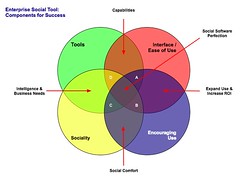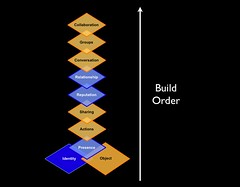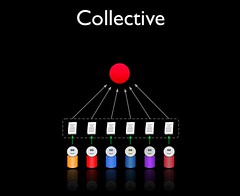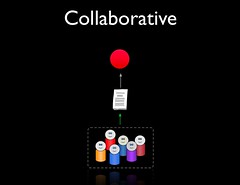During the last couple of years, since Slack has been publicly available, it has taken off like wildfire. To many it is "just a chat service", which gets derided and belittled like most chat services do. This is until they find that chat has not only a place in organizations it has lasting value in organizations, proven out over the last 5 to 8 years (if not longer). Slack, much like prior chat services, do really well in organizations. As a "presence service" (is the person at their desk or available) and a means to ask a quick question or have a quick discussion (synchronously or asynchronously). Over the last 5 to 8 years chat and messaging services took off in organizations. This is not they took off and became popular in pockets of organizations, but have become standard tools everywhere. Messaging not only became the norm, but in many (if not most) organization the messaging platform is second most used service behind email (often Outlook) that is centrally supplied and supported (I know a few organizations where messaging is used more than email and is their most used application / service).
If the email client is Outlook, more than likely the messaging service has been Lync (now rebranding to Skype for Business). The downside to Lync isn't that it is used heavily, but it isn't supported well enough with archiving and with solid search capability. Many IT shops say all the messaging (even if just text based) would eat loads of space to store it. It is a capacity problem in IT's perspective, which when broken down on a per person level it is less than a few gigs of text per year that are created from active users. The last few years Lync has been used heavily for internal voice and video (where allowed) messaging, which not only eats storage at a faster rate, but voice search is still not commercially available with good enough accuracy at a low enough price to be viable for voice in practice. The last issue has little to do with capacity, but is compliance focussed and storing of messages isn't seen as compatible with the organization's policies, which means many of their other knowledge capture capabilities are likely crippled to some degree as well. But, for organizations that believe storing messages and supplying really solid search is limited by capacity constraints a tool like Slack becomes the organization's dream.
So, Slack is a better messaging service?
Well, Slack didn't become popular (these days try and find an organization that isn't using Slack in it somewhere and paying to use it) because it was just another messaging service. There are loads of chat and messaging services for business and enterprise, like HipChat (the largest most similar product), Lync / Skype for Business, Jabber based services, or other less capable services that were developed by those who misbelieve chat is just simple and easy to make. What has Slack standing out is (similar to HipChat) syncing across all platforms, from your pocket, to your desk, or on your coffee table / sofa. But, unlike HipChat, Slack stood out for being not only easy to use, but fun to use. Part of this is the helpful Slackbot that guides users and provides assistance with a playful, yet helpful personality (personality that fits a service and need is incredibly helpful with bots is it help discern with service and bot you are interacting with in our lovely human brains) as well as the myriad of other bots that are available to add in.
Why is Slack people's buddy?
But, this isn't the whole reason Slack is being used, spreading widely, and relatively quickly. Slack is more than chat, which can be used quickly to interact with others and keep information out of email. But, Slack and its personality(ies) address some most acute pain points that are in every organization: Knowledge capture and retrieval; Search; and Interoperability / integration. All three of these organizational maladies not only have long been problematic most of the "solutions" for them over the years suck (to put it politely) for the people using them.
It is important to keep in mind Slack is founded and built by game developers who focus on creating fun and engaging environments. They deeply get staying away from creating pain points for customers / users, as well as reducing them - this isn’t the clicksperts gamification, it is real game mechanics and game design models / theory at work.
Knowledge capture and retrieval
Email has for more than a decade or two been known as the death bed for knowledge in organizations where things are captured and shared are never to be seen again. Yes, think of the cesspit that is email (we've known this problem for 20+ years) with each email little envelope not as that nice friendly symbol but as a tombstone for the dead / never to be live again knowledge within it. It is now you have got the reality of the last 20 plus years. But, more open systems that allow for capturing, sharing, and most importantly searching have really good value to move things forward.
Many organizations value capturing the knowledge they create and have within it. They also have interest in having that knowledge shared and found by others who can benefit from it, so the organization gets smarter faster. The key pain point is capturing what is known, often this is set as a separate set of actions and activities from what people do in their regular workflows and conversation / interaction models. This separation of flow and spaces decreases the use of the knowledge services. These separate services have their place and value as spaces and places for focussed (either team task focussed, project relevant investigations, or subject interest focussed) discussion and development of ideas. But, the conversations that happen in the flow of work are valuable to capture as they happen, then have them addressable / linkable and searchable.
Services that capture conversation and communication in open, historically captured, and addressable spaces have long been far more valuable than email. This value is replicated often with the ever present situation of bring somebody new into the team, project, and / or conversation. The context and history is there to be seen, the important items can be marked or pinned in a manner so they stand out as well as getting context around those items in their original context. Getting a new person conversant and in the flow of things (as well as not out of the loop in conversations that are current) is incredibly valuable when trying to get things done and done well.
Slack provides that means to capture the conversations as they happen. It provides the means to pin (and now with emoji responses, a hackable means) relevant valuable chunks of the conversations and streams.
Good search (yes, you read that right)
Search in and across enterprise, is often painful as it is not very good at finding things. One of the benefits of Slack for many is the search is quite good. Not only is Slack good at retrieving past messages and conversations, but anything that is linked to in Slack or attached as shared objects (text related or with text metadata) in Slack all become searchable. When the linked items or objects are returned in search they are surfaced within the context of the conversation they were shared. People using Slack in organizations have been amazed with the quality of search for finding and refinding shared knowledge and resources, but also relating the item to why and how it was shared. To those who are deprived of viable search in organizations Slack is a real treasure.
Most enterprise search provides success in only 4 of 5 attempts (this adds up to being roughly $375 of cost for unproductive / counter productive time per employee per year when looking at it through an extremely conservative lens (others estimate 4 to 10 times this cost per employee per year). Just the value of improved search, as well as bringing information into context and having it searchable ads greater value from moving the dark matter into the searchable light.
Search in Slack is most often better than the enterprise search that people use across their organization. But, it also is often better than the search that is built into various platforms that are used in and across the organization, including enterprise social networks (some exceptions to this include KnoweldgePlaza, which has really good search within it, as that is a large part its purpose). This improvement in search finds what is needed and the search result surfacing the item in context is really special. Slack has also designed this really well, which adds to the ease of use and enjoyment.
Integration and Interoperability (What? Really?)
Another big pain point in organizations is integration and interoperability. There are disparate systems which many people have to pay attention to metrics, messages / alerts, and charts from various services across them, which is not efficient and rarely is there an integrated view (nor a means to interact across different systems from one interface). But, rarely is there a means to search within and across the services to do quick comparisons or easily bring those things into a more unified view. Often IT has the integrations far down on their prioritized to do list or in the "can not be done category" for reasons of feasibility or difficulty. But, one of the beauties of Slack is it integrates with other services relatively easily through a variety of methods (many can be done in a day or two in side-project time), if there is access to an API or even a means to see a screen so it can be parsed for values and meaning. Groups have been able to pull together their own aggregated and searchable views (sometimes in their own channel to view / review and search within or as a system with an identity that chats and shares things out as a bot). The solution that is cobbled together in side-project time to meet the needs of employees meets their jobs to get done and need that access requirements, which make Slack far quite efficient and usable. While IT has their requests slowly (if that) moving through the prioritization process, employees have been able to drastically reduce the pain points that nudge them to consider looking employment opportunities that value their getting work done.
Sane payment models
One of the last, often overlooked, elements goes completely against the trend of "evil" enterprise service payment models of paying for seats (used or unused). This model is loved by nearly all enterprise software vendors (or their boards - somebody has to love it as it surely isn't the customers who know they are being taken for a ride).
Slack treats paying for their software / services differently. It runs on a freemium model, but has high conversion rate to paying customers for its offerings. It is not that paying users get full search of the a complete archive and more plug-ins, but also quite good support (yes there are a few others that give quite good support - though this isn't the norm). The pay model provides improved search powers and interoperability / integration, which being severe pain points in organizations make it worth paying for and the pricing per user makes that a bargain (hey Slack don't go changing the price though).
Yet, what really makes Slack's payment model special and different is you only pay for accounts used that month. (Did I hear a collective "WHAT?") Yes, you don't pay for the number of prospective seats nor tied into long contracts that go beyond the needed time span. Ever try to get a reduction in seats paid for after a few months when you have realized only 60% of the seats paid for are used and that doesn't look like it will shift over the next 18 to 30 months of the life of the lock-in? Slack understands that pain and opted to not partake in that model of pain.
In short Slack reduces pain and increases efficiency and value
So, the reasons why Slack seems to be at the tip of many business and enterprise tongues (as an inquiry or recommendation) is focussing on what is delivered, its ease, and the value people get.
Slack aims at delivering a usable (and friendly) service as a means to communicate to get and share information and knowledge. But, in doing this also knocks out some nasty pains people in organizations really don't like and have long wanted resolved. Slack is basically the un-enterprise solution as it focusses on being easy to use, reduces pain points, and tries to be friendly. Yes, this is software for the enterprise, or for the parts that don't relish pain.
So Slack is perfect and the cure all?
Um, no. Slack is far from perfect. It isn't trying to be everything. So, you are wondering what are the pain points or limitations?
Slack isn't going to scale to meet your hundreds or thousands of employees needs today
Slack works relatively well up to a few hundred people (there are many hundreds using in one installation (instances well over a thousand as well), but that isn't optimal). And even with keeping an installation under a couple hundred people it is still going to be a bit noisy. Many of these installations with more than 100 people in them use the channels for creating smaller groups / teams / projects / targeted conversations.
While improvements are need to get to solid filtering, this does help so important things don't get missed, or conversations that could use a person's input gets their attention when they weren't specifically called out. The ability to move conversations to and between channels (in a manner that leaves a trail behind where the conversation started).
It also needs the ability to more easily tie conversations threads together and tie related discussions together through tags (yes, I said the tags word) [the addition of each entry now having the ability to get emoji responses has been getting used to aggregate related content in some organizations in a "visual tagging" way, but lacks clarity in understanding, even with "what each emoji means" charts]. Also, finding related threads and discussions across channels can be cumbersome in search when different terms (synonyms / fungible technical terms) are being used, even if search is good.
Not everything nor everybody works in the open
In organizations there are viable and valuable reasons to have some things not shared openly. Legal, regulatory, compliance, and some things are best tested and considered among a few people and honed / vetted before sharing more widely and other needs for improving social comfort are often lacking in the enterprise social platforms.
Many mature social platforms for enterprise now offer private spaces for groups to share information, and if it seems viable or gets honed / edited it is shared it out more broadly. Many even follow the social progression of fire model where trends in the messages / sparks and comments are seen as being connected and possibly need more investigation, then moved to or collected in a small comfortable space / campfire to investigate before sharing more broadly / campfire (if it is deemed worthy of moving it forward), and then honed through collaboration and perfected to be put into production / torch.
By the way - Slack does offer the capability of not remembering things for paid users as some organizations require this for compliance. There is a forget quickly, forget in a week or so, and keep everything capability to meet a variety of needs / requirements of organizations [this forgetting negates the incredibly helpful search, but organizations that require this often have bigger troubles that they are dealing with]. But, global forgetting isn't the same as quiet comfortable groups with permeable walls that work well for many people in larger organizations with cultures heavy on the Western European and North American sensibilities.
Slack doesn't replace everything
There have already been some rather poorly considered (mostly through the lack of understanding the diversity and complexity of social - no it isn't simple nor just complicated) "we are going to use Slack to replace..." attempts. Understanding the category / class of tool that Slack falls into is essential. It isn't a replacement for the collective, curation, nor team / group workspaces like Jive and others (yes, there is one service in this category / class that nearly everybody wants to move away from as fast as they can, but Slack isn't the tool to move to as a replacement). Slack does well to sit alongside those services for conversational interactions and sharing results out of them. It isn't going to replace a social search and collective aggregation service like KnowledgePlaza. Slack not only integrates things into itself, but also can have what is in it as fodder to integrate out, so conversations and things shared in Slack can be honed and more deeply framed and considered in other services and then have results and outcomes of those considerations shared back into Slack.
Slack is not going to replace your document management service. It is a good partner for it to add context and easily drop documents that are relevant from the service into Slack. But, Slack isn't going to replace document management, even if its search is good, the versioning, permissions, and access controls for compliance and other valid needs aren't there in Slack. Your document management service could become more pleasurable to use though.
Enterprise is a complicated beast
Having worked in and around social software for enterprise for about 20 years now, it is a wicked space. There are a lot of "needs" that Slack doesn't comply with yet. There are a lot of issues that aren't on Slack's horizon yet, it may not want to place them there.
Enterprise also brings with it a diversity of needs, mental models inside, use cases, workflow models, and more that should be and could be addressed, but Slack isn't there yet. I'm not sure Slack even has all of them fully on their radar - many organizations don't centrally have them on their radar yet either. But needs arise when divisions and groups underserved by centrally chosen tools in an organization that doesn't fit their needs. When this happens groups often will go in search of services and tools that meet their needs to help them get the job done.
Working with enterprise means working with organizations that don't understand how they themselves actually work nor operate in workflows nor knowledge flows. Many social platforms aren't in the business to help organizations understand their needs, problems, pain points, and gaps yet these are the first steps to understanding the right fit for tools. Analysts, for the most part, aren't in this business, nor are most consultants (selling solutions based cookie cutter decision models makes more profit than the deep understanding the problems before considering solutions model). Perhaps Slack could embrace this model of helping organizations understand themselves, as they aren't focussed on "winning" as much as helping solve problems and address needs (another reason Slack stands out and has a good helpful product).
So what should you do?
The first step is to take Slack seriously. It is doing a lot of things really well, as well as weekly and monthly iterations making things even better.
Also understand not only what Slack is, but what it isn't. Understand how your organizations works (if you need help with that reach out to me, as helping organizations see clearly through the fog of complexity is what I do) and sort out how a service that focusses on reducing pain points and increases people's ability to get things done can fit.
Second, start early thinking about filtering to cut through the noise for alerts and reducing "noise". Work out a community guide and plan. Also, sort out the flow models that can work well with the other services in the organization.
![Reblog this post [with Zemanta]](http://img.zemanta.com/reblog_e.png?x-id=db7a8b23-e75c-4cf7-bc51-4a3302e7cf8b)
![Reblog this post [with Zemanta]](http://img.zemanta.com/reblog_e.png?x-id=dd8ff81b-9f75-421c-ade6-4c792947ef01)



